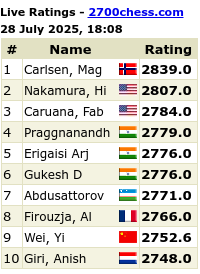RMD – ALD, 11/11/2004 [C47]
1. e4 e5 2. Nf3 Nc6 3. Nc3 Nf6 4. d4 exd4 5. Nxd4 Ne5 [Unusual and not best. Correct is 5. … Bb4.] 6. Bf4 [6. f4 is a stronger reply to Black’s weak fifth move.] Ng6 7. Bg3 Bb4 8. Qd3 [8. Bd3] O-O 9. a3 Bc5 10. Nd5 [10. Be2] Nxd5 11. exd5 Qf6 [11. … Re8+] 12. c3 [12. O-O-O] Ne5 [12. … d6] 13. Qf5 Qxf5 14. Nxf5 d6 [14. … Re8] 15. Ne7+ Kh8 16. Nxc8 Raxc8 17. b4 Bb6 18. Be2 Rfe8 19. O-O Re7 20. Rac1 Rce8 21. Bb5 Nd7 22. a4 a6 23. Bxd7 [23. Bd3] Rxd7 24. Rfe1 Rde7 25. Rxe7 Rxe7 26. Kf1 h6 27. a5 Ba7 28. Re1 Rxe1+ 29. Kxe1 b6 30. axb6 Bxb6 31. Ke2 a5 32. bxa5 Bxa5 33. c4 Kh7 34. Bh4 f6 35. f4 Kg6 36. g4 h5 37. h3 hxg4 38. hxg4 f5 39. Kf3 Bb6 40. Bd8 Ba5 41. Be7 [41. c5!? was worth a try.] Bb6 42. Bf8? [White could maintain the equilibrium with 42. Bh4, but this move gives Black an unexpected opportunity] Ba5? [An opportunity on which he does not capitalize. 42. … fxg4+ 43. Kxg4 Kf7.] 43. c5? [43. Be7] dxc5? [43. … Kf7] 44. Bxc5 fxg4+ 45. Kxg4 Bc3 46. f5+ [46. Be7] Kf7 47. Ba7 g6 48. Bb8 [The game could have been abandoned as a draw at this point.] gxf5+ 49. Kxf5 Ba5 50. Ba7 Bb6 51. Bxb6 cxb6 52. d6 Ke8 53. Ke5 Kd7 54. Kd5 b5 55. Kc5 b4 56. Kxb4 Kxd6 ½-½
RMD – ALD, 11/14/2004 [B88]
1. e4 c5 2. Nf3 Nc6 3. Bc4 e6 4. O-O d6 5. d4 cxd4 6. Nxd4 Nf6 7. Nc3 Be7 8. b3 [In this line, this square is usually reserved for the bishop.] O-O 9. Be3 Bd7 10. Qf3 [10. f4] Ne5 11. Qg3 Nxc4 12. Bh6? [Trying to get fancy. 12. bxc5 should be played immediately.] Ne8? [Missing 12. … Nh5, which allows Black to keep the extra piece.] 13. bxc4 Bh4 14. Qg4 e4 [14. … Rc8 is stronger. Now the position is completely even.] 15. Nf5 Bxf5 16. exf5 Rc8 [16. … Kh8] 17. Nb5 a6 18. Na7 [Odd] Ra8 19. Be3 Bf6 20. Rab1 Qc7 21. Qe4 Rb8 22. Qd5 b6 [22. … Be7 - RMD] 23. Nc6 Rb7 24. f4 exf4 25. Rxf4 [25. Bxf4 puts strong pressure on the d6 pawn.] Be5 26. Nxe5 dxe5 27. Rff1 [Not the best square for the rook; it prevents doubling.] Nf6 28. Qd3 Rc8 29. c5 bxc5 30. Qxa6 Rxb1 31. Rxb1 h6 [31. … Ng4 is better; after 32. Bxh6 the position would get exciting.] 32. c4 Qc6 33. Rb6 Qa8 34. Rxf6!? [A shot from the blue.] gxf6 35. Qxf6 Rc6 [35. … Qa5] 36. Qxe5 Qc8 37. f6 Qf8? [This does not actually protect the h6 pawn; actually, this loses.] 38. Bc1? [Missing the win after 38. Bxh6! Qxh6 39. Qe8+ Qf8 40. Qxc6.] Re6 39. Qg3+ Kh7 40. h4? [40. Qf4] Qg8? [40. … Rxf6] 41. Qd3+ Qg6 42. Qxg6+ [I don’t have a specific suggestion, but trading Queens is probably not best. Black has an edge in the endgame, but with the queens on the board I don’t see a win.] Kxg6 43. Bb2 [43. Ba3 put up a stronger defense.] Ra6 [43. … Re4 - RMD] 44. a3 Rb6 45. Be5 Rb3 46. Bd6 Rxa3 47. Bxc5 Rc3 48. Be7 Rxc4 49. g3 Rc2! 50. Kf1 h5 51. Kg1 Kf5 52. Kf1 Kg4 53. Bd6 Rc6 54. Be5 Re6 55. Bf4 Rxf6 56. Kg2 Rxf4! [The fastest way to the win.] 57. gxf4 Kxf4 58. Kh3 f5 59. Kg2 Kg4 60. Kf2 f4 61. Kg2 f3+ 62. Kf2 Kf4 63. Kf1 Kg3 64. Kg1 Kxh4 65. Kf2 Kg4 66. Kf1 h4 67. Kg1 h3 68. Kh2 f2 69. Kh1 f1=Q+ 70. Kh2 Qg2#
Subscribe to:
Post Comments (Atom)

No comments:
Post a Comment